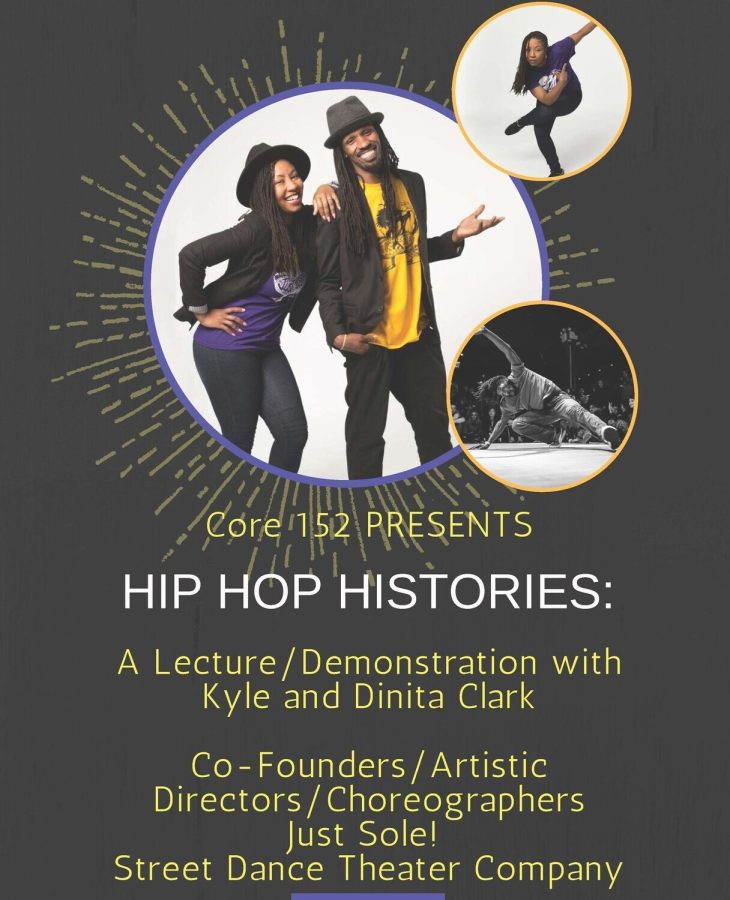Hip Hop Histories Comes to Colgate
On Friday, March 4, Kyle and Dinita Clark, co-founders of Just Sole!, an award winning street dance theater company performed and spoke in the Brehmer Theater. In 2012, the husband and wife duo were appointed international ambassadors for American arts by the former President Barack Obama Administration, and have since competed and performed worldwide.
As students filed in, Dinita Clark relegated herself to the front corner of the stage and stretched, while her husband spoke with the people occupying the first few rows. Finally, as the room filled out, he stepped to the center of the stage, mic in hand.
“In the words of Jay Z,” he began, “allow me to reintroduce myself.”
The pair have come to campus nearly every semester since 2018, sponsored by the core 152 “Challenges of Modernity” course.
With the help of student dancers and Dinita Clark’s demonstration of various moves, Kyle Clark created an interactive timeline of hip-hop’s development.
“Robot!” he cried, and in response, Dinita Clark stiffened at the joints and swung her body around.
And so it went, from the Don Point (pointing out into the crowd with hyperextended elbows) to Popping-and-Locking (a sharp pop of the chest followed by a relaxation).
After Dinita Clark had shown off a few moves from each era of the developing hip-hop dance style, a group of five students strutted onto the stage and danced a choreographed set.
First-year Clara Christopherson, who was among the students who performed on stage, found working with Kyle and Dinita Clark to be both exhilarating and informative.
“The hip-hop workshop was incredibly hard,” she said. “We began practice on Monday and performed the same Friday – a total of four dances and over 20 hours of practice. I don’t regret a minute of it, though. Working under Kyle and Dinita has been an inspiration and I hope to dance with them again.”
The crunch time and tireless practice paid off: the audience perked up and cheered their classmates on each time they came on to demonstrate their expertise. The engaging dynamics of the student dancers were woven skillfully with the tidbits of dance and music history provided by the Clarks.
“The extra dancers did a great job,” first-year Kaleigh Wright said. “It was very impressive that they learned those in just a few days. Also, I now know what an A-track is and impressed my parents with that.”
According to Kyle Clark, hip-hop began with social dances; unchoreographed and localized movements meant to identify and distinguish people from different areas.
“Social dance is the bedrock of any codified form,” he said. “Music is a reflection of politics; if music is an action, then dance is the reaction. It’s a part of the universal human experience. To know music is to know humanity.”
DJ Kool Herc, one of the fathers of the genre, was of a similar mindset. In the Bronx in 1973, just after a major resolution of gang divides within the city, people and styles of dance began to mix. Kool Herc hosted a party that August and noticed that the attendees from all five boroughs of New York City danced almost exclusively to the breakdowns or drum solos of each song.
He responded to the way in which people interacted with music, and set up a record player to exclusively play the breakdowns of various funk songs. It was then that hip-hop came to life as a genre. And so hip-hop music, the action, brought about breakdancing, the reaction.
“Dance is a language,” Kyle Clark said, “with introductions, regional dialects, signatures and personal differences, just like an essay.”
It is dance’s category as a cultural language that makes it so important to avoid the so-called “appropriation monster.”
“Cite your sources,” Kyle Clark said. “If you do it for collegiate papers, do it for cultural practices. If you eat someone’s food for thought, you’d better clean the dishes.”







